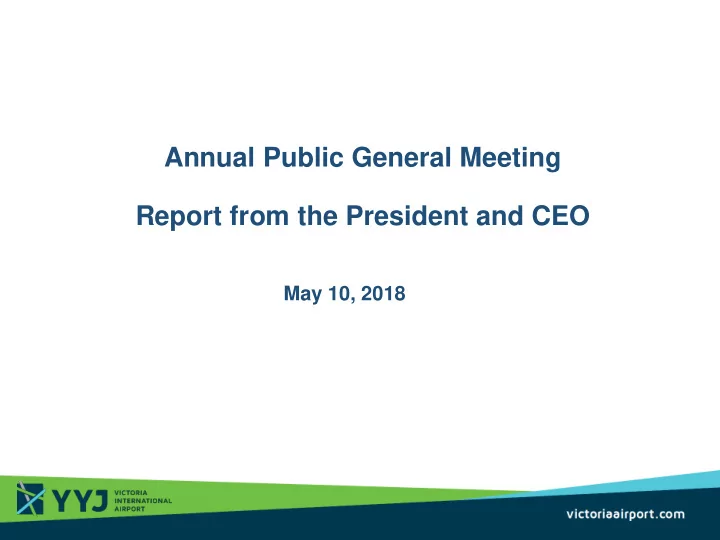

Annual Public General Meeting Report from the President and CEO May 10, 2018
Air Access is a Key Component of Economic Growth 15 Non-Stop Destinations 7,100 Seats Per Day
Economic Impact of Canada’s Airports
YYJ Economic Impact Employment Wages GDP Output Impact ($ millions) ($ millions) ($ millions) Jobs FTEs Direct 2,800 2,500 $170 $230 $540 Indirect 1,100 1,000 $60 $100 $200 Induced 800 700 $40 $90 $140 4,700 4,200 $270 $420 $880 Total FTEs = Full Time Employees Induced = Direct and indirect employees spending in the economy
Direct Employment: 2,800 Jobs
2017 Baseline Community Noise Survey Purpose: To compare 2017 and 1999 baseline noise levels, document aircraft noise exposure levels and overall community noise exposure levels. Methodology : 12 locations monitored for a 24 hour period between August 19 - 24, 2017 Locations: Repeated monitoring at 6 of 7* sites from 1999 * The original 1999 measurement location in Arbutus Ridge could not be found; therefore, an alternative location was chosen. Added an additional 5 sites in order to have a baseline moving forward
2017 Baseline Community Noise Survey New Noise Monitor New Location for 1999 Monitor Same Location as 1999 Monitor
2017 Baseline Community Noise Survey Conclusions In general, community aircraft noise exposures were found to decrease relative to the 1999 survey results. Site # Location 1999 Ldn 2017 Ldn Increase (dBA) (dBA) (dBA) 3 Iroquois Park 66 65 -1 5 Glenelg Ave <50 50 N/A 6 Carmanah Terrace 49 48 -1 8 Rathdown Park 57 52 -5 9 John Road 57 50 -7 11 Tapping Road <55 54 N/A Ldn = Day-Night Equivalent Sound Level – the average noise level over a 24-hour period dBA = A-weighted decibels – the relative loudness of sounds in air as perceived by the human ear
Canadian Airport Traffic 1988 - 2016 Canada Air Passenger Traffic Enplaned/Deplaned 160 140 120 Passengers (Millions) 100 80 60 40 20 - 1988 1993 1999 2004 2009 2014 Domestic Transborder International
Existing Domestic Airlines are Evolving Swoop ULCC Rouge Expansion Link Regional Growth AirCanada WestJet International Focus Delta Joint Venture Efficiency MAXAircraft MAX &CSeries Aircraft Int’l Expansion
New Airlines are Entering the Market Ultra Low Cost Carrier (ULCC) model proposed in order to generate incremental demand Currently Operating Launching June 2018 PursuingFinancing New ManagementTeam Separate from WestJet Targeting 40% CheaperFares
Scheduled Seat Capacity - Domestic Domestic Canada Scheduled Non-Stop Seats Annual Turboprop + Regional Jet Percentages 49% 30% 37% 41% 48% 70 60 Annual Seat Capacity (millions) 50 Widebody 40 Narrowbody Regional Jet 30 Turboprop 20 10 0 1998 2004 2008 2013 2017 Source: Official Airline Guide Schedule Data, full year data for 1998; Diio Mi Schedule Data, full year data for 2004, 2008, 2013, 2017.
Passengers Per Aircraft Canada: 1980 - 2016 80 Average Passengers per Aircraft 70 60 50 Passengers 40 30 20 10 0 1980 1985 1990 1997 1998 1999 2000 2001 2002 2003 2004 2005 2006 2007 2008 2009 2010 2011 2012 2013 2014 2015 2016 Source: InterVISTAS Calculations with data from: Aviation in Canada (1980-1990) and Table 401-0009, Statistics Canada and Air Carrier Traffic at Canadian Airports, Statistics Canada
YVR Hub
SeaTac International Expansion Credit: Port Of Seattle
Montreal Photo Credit: i.Imgur.com
Whitehorse Photo Credit: ImagoBorealis.com
Flair Airlines Daily Edmonton Service Photo Credit: Alberta Drone Pilots
YYJ Demand Annual Passengers 3,500,000 3,309,236 3,250,000 3,000,000 2,678,274 2,750,000 2,500,000 2,359,049 2,250,000 2017 annual passengers 1,934,842 2,000,000 1,750,000 1,500,000 1,250,000 1,000,000 2011 2012 2013 2014 2015 2016 2017 2018 2019 2020 2021 2022 2023 2024 2025 2026 2027 2028 Master plan 3% 5% Actual
Financial Approach • Maintain strong balance sheet • Keep airline operating costs in lowest quartile • Diversify revenue sources • Non-aviation as a percentage of total (67%) • Prudent staged capital investment • Focus on the customer and quality
Real Average Fares Indexed to 2016 Average Fare for Major Carriers $400 $350 $300 Average Fares $250 $200 $150 $100 $50 $- 1997 1998 1999 2000 2001 2002 2003 2004 2005 2006 2007 2008 2009 2010 2011 2012 2013 2014 2015 2016p Source: Statistics Canada Average Fare data, Cat. 51 -004-X p = preliminary Major Air Carriers include Air Canada (mainline, AC Jazz & AC rouge beginning July 2013), WestJet, and Air Transat
Low Cost Focus Airport Q400 B737-700 A319 Victoria $363 $734 $784 Kelowna $390 $741 $768 Regina $486 $1,026 $1,097 Saskatoon $452 $878 $910 Quebec City $584 $1,230 $1,277 Vancouver $588 $1,240 $1,301 Calgary $518 $1,150 $1,230 Toronto $1,038 $2,077 $2,220 Montreal $1,121 $2,144 $2,297
Q400
Lower Hold Room Expansion
Lower Hold Room Expansion
Lower Hold Room Expansion
Lower Hold Room Expansion
Lower Hold Room Expansion
Lower Hold Room Expansion
Lower Hold Room Expansion
Lower Hold Room Expansion
Lower Hold Room Expansion
Parking Expansion 2018
Terminal Precinct Pavements
Reay Creek Detention Pond
Robotic Mower – “Moe”
Airport Service Quality 2017 Results YYJ Ranked First Overall of 15 Canadian Airports
“Victoria International Airport offers a very high level of service. From bottle refill stations for folks who had to replenish water after dumping out their water going through security to having local outlets such as Spinnakers instead of global chains, it is a very high-quality airport. Airlines, meeting planners and leisure tour operators notice the difference.” “This makes a difference to customers, which in turn builds customer loyalty. Customer loyalty along with strong macro fundamentals, such as tourism growth, both contribute to growth.” Paul Nursey President and Chief Executive Officer Tourism Victoria
Questions
Recommend
More recommend